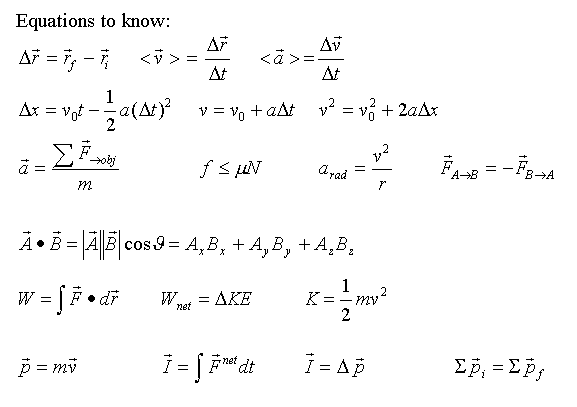
Contents
1. Some comments
2. What will be on the test
3. Equation sheet
4. Test format
5. Examples of questions
1. Some comments
On problems, it is important to show how you reasoned from the information given in the problem to your final answer. The correct final answer with units is only worth 2-3 points. The remainder of the points are given for the quality of your solution. You need to include the following to receive full credit:
- All the information given in the problem with correct units (This may include a diagram)
- A statement of what quantity you are trying to find.
- State explicitly what physics principle you are using to solve the problem
- Solve for the unknown quantity in symbols explicitly before numberic calculations
- Then substitute numbers with units and calculate the numeric answer
Extra credit will be given for checks made to see if the answer is reasonable
Be prepared to make reasonable estimations and state your assumptions when solving problems. Be aware of significant digits in your answers. (Keep lots of digits until the final calculation, then round to the appropriate precision.)
Here are some really good tips on test taking from Dr. Richard Felder's website at North Carolina State University.
If you have ANY questions while taking the test, please be sure to ask the instructor. The purpose of the test is not to give you trick problems to catch you in an error. The purpose is to give you an opportunity to "show what you know" ! The test problems are based completely on the reading, the lectures, and the homework. If you understand the main ideas and how to apply them, you'll do well.2. What will be on the test
Be sure to carefully review your notes, especially when we do things that are not covered very well in the book. Looking over the individual class days linked to the calendar on the class website will also help refresh your memory. Although this test is comprehensive, the test will emphasize material from chapters 3, 4, & 5.
For this test, you should be able to do the following things:
Chapter 0 Measurement, Estimation, and Units
Chapter 1 Concepts of Motion
Chapter 2 (Vectors & Coordinate Systems)
Chapter 3 Kinematics: The Mathematics of Motion
Chapter 4 Force and Motion
Chapter 5 Dynamics I: Newton's 2nd Law
Chapter 6 Dynamics II: Dynamics in a Plane
Chapter 7 Dynamics III: Newton's Third Law
Chapter 8 Momentum and Its Conservation
Chapter 9 Concepts of Energy I: Work and Energy
Equations:You will need to know the following equations and under what conditions they can be applied:

Should also know formulas for:
Conversions (rules of thumb):
Numbers to know:
You will need to be able to derive specific equations you need from these equations listed above. You will also be given any additional constants and conversions you need. Unless told otherwise, you may use - 10 m/s/s for the acceleration due to gravity.
4. Test Format:
Full period on Monday, November 19, 2001
| Part I | |
| Group Problem using GOAL Protocol |
|
| Part II | |
| Multiple Choice or short answer question,
typically 4-5 parts
(no explanation required, but no partial credit either) |
20 points |
| Estimation Problem | 15 points |
| Short Essay ( Mainly looking for an answer in words - about a paragraph, but equations, diagrams, and graphs OK. No calculations allowed) |
10 points |
| 2 Problems based on Homework and Lecture – 10-20 points each | 30 points |
|
|
100 points |
If the overall test average of your entire group is 75% or above, every member of your group will receive a bonus of 5%.
Bonus points for problems 2,4, & 5 are awarded for showing work to check your answer for reasonableness or for using GOAL.
Note: Many of you commented that you ran out of room on the first test. This time the test will be printed single sided so this should not be a problem.
5. Practice Test 3 / Solutions P1, P2, P3, P4, P5, & group